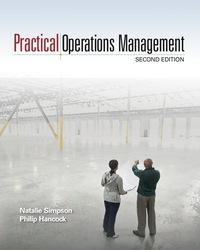Rothera Point Utilities operates Rothera Point Power Plant, a coal-fired generation facility that operates continuously, provid- ing
Question:
Rothera Point Utilities operates Rothera Point Power Plant, a coal-fired generation facility that operates continuously, provid- ing electricity to nearly 700,000 households in its service area. Rothera Point Plant consumes coal at a steady rate of 350 tons an hour, supplied through a contract with a coal mine over 1,500 miles from Rothera Point. Coal is delivered over this dis- tance by rail, in dedicated coal trains rented by Rothera Point Utilities. Each railcar in the train carries 110 tons of coal and can be loaded at the mine or unloaded into Rothera Point's coal stockpile in about 2 minutes. However, travel of that rail- car between the coal mine and Rothera Point Plant requires an average of 30 hours to complete. Rothera Point determines the overall lengths of its dedicated coal trains, also known as unit trains, by determining how many railcars to rent from its logistics provider. His- torically, Rothera Point has rented and operated two maximum-length, 150-railcar unit trains, dispatching each train to the mine as needed, to keep the plant stocked with coal. This results in a complex delivery schedule, during which each train is sometimes operat- ing and sometimes idle. Recently, managers at Rothera Point decided to convert this com- plex push-style scheduling of the unit trains into a leaner, pull-style operation in which Rothera Point unit trains circulate continuously between the mine and the Rothera Point plant. With this change, the round-trip travel of the unit trains becomes a form of kanban loop, in which the mine loads trains that arrive empty, the Rothera Point plant unloads trains that arrive with coal, and the trains themselves require no scheduling or other explicit instructions, as they simply keep moving. However, operating the current two 150-unit railcar trains in this fashion delivers coal to the plant faster than the plant con- sumes it, so the managers at Rothera Point realize the two Rothera Point unit trains must be shortened to implement this leaner system. Operating the coal supply and unit trains as a leaner, pull-style system has other advantages. Idle coal in inventory is relatively easy to store, but it poses environmental concerns. Rothera Point's coal inventory consists of pipeline inventory stored in its open railcars in transit, and its own outdoor coal stockpile where the arriving coal is depos- ited for use by the plant. When coal is stored outside, coal dust can be carried by windy weather and deposited in other areas. While Rothera Point maintains systems to suppress this potentially harmful dust as much as possible, management has resolved to reduce overall average coal inventory levels to curtail it further. There has even been discussion of renting a third unit train, which would allow all unit trains to be even shorter, haul- ing coal in lesser amounts and reducing average inventory further. Each unit train brings with it the substantial fixed cost of operating its engines, so the benefit of adding an addi- tional train would have to outweigh its additional fixed cost.
Questions
1. Assume that Rothera Point will always operate unit trains of equal length, to achieve the smoothest flow of coal delivery possible. Recommend the number of railcars that should be in each of its two unit trains to achieve a lean but adequate flow of coal between the mine and the Rothera Point plant.
2. In your two-train pull-style system, what is the average pipeline inventory? What is the average size of the coal stockpile at the Rothera Point plant? How much smaller is this stockpile than the one Rothera Point must have under its current 150-railcar unit train delivery system?
3. Recommend the number of railcars that should be in each of its unit trains if Rothera Point were to add a third unit train to its coal delivery system. By how much does this improve inventory levels, compared to the two unit train system?
Step by Step Answer:






